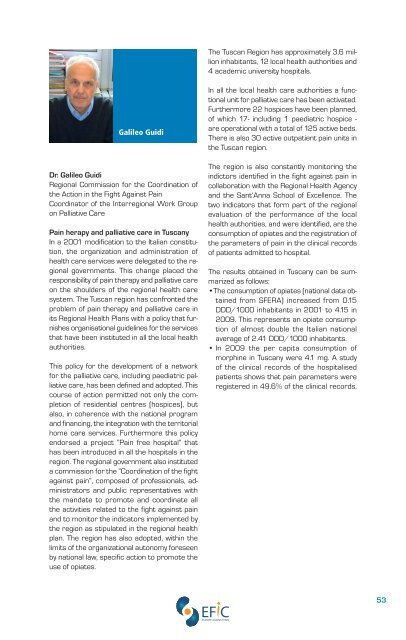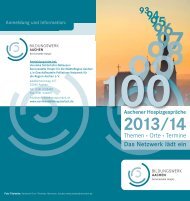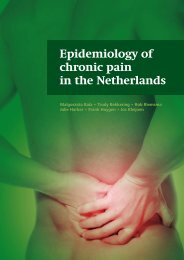First EFIC® Symposium Societal Impact of Pain - SIP
First EFIC® Symposium Societal Impact of Pain - SIP
First EFIC® Symposium Societal Impact of Pain - SIP
You also want an ePaper? Increase the reach of your titles
YUMPU automatically turns print PDFs into web optimized ePapers that Google loves.
Galileo Guidi<br />
Dr. Galileo Guidi<br />
Regional Commission for the Coordination <strong>of</strong><br />
the Action in the Fight Against <strong>Pain</strong><br />
Coordinator <strong>of</strong> the Interregional Work Group<br />
on Palliative Care<br />
<strong>Pain</strong> herapy and palliative care in Tuscany<br />
In a 2001 modification to the Italian constitution,<br />
the organization and administration <strong>of</strong><br />
health care services were delegated to the regional<br />
governments. This change placed the<br />
responsibility <strong>of</strong> pain therapy and palliative care<br />
on the shoulders <strong>of</strong> the regional health care<br />
system. The Tuscan region has confronted the<br />
problem <strong>of</strong> pain therapy and palliative care in<br />
its Regional Health Plans with a policy that furnishes<br />
organisational guidelines for the services<br />
that have been instituted in all the local health<br />
authorities.<br />
This policy for the development <strong>of</strong> a network<br />
for the palliative care, including paediatric palliative<br />
care, has been defined and adopted. This<br />
course <strong>of</strong> action permitted not only the completion<br />
<strong>of</strong> residential centres (hospices), but<br />
also, in coherence with the national program<br />
and financing, the integration with the territorial<br />
home care services. Furthermore this policy<br />
endorsed a project “<strong>Pain</strong> free hospital” that<br />
has been introduced in all the hospitals in the<br />
region. The regional government also instituted<br />
a commission for the “Coordination <strong>of</strong> the fight<br />
against pain”, composed <strong>of</strong> pr<strong>of</strong>essionals, administrators<br />
and public representatives with<br />
the mandate to promote and coordinate all<br />
the activities related to the fight against pain<br />
and to monitor the indicators implemented by<br />
the region as stipulated in the regional health<br />
plan. The region has also adopted, within the<br />
limits <strong>of</strong> the organizational autonomy foreseen<br />
by national law, specific action to promote the<br />
use <strong>of</strong> opiates.<br />
The Tuscan Region has approximately 3,6 million<br />
inhabitants, 12 local health authorities and<br />
4 academic university hospitals.<br />
In all the local health care authorities a functional<br />
unit for palliative care has been activated.<br />
Furthermore 22 hospices have been planned,<br />
<strong>of</strong> which 17- including 1 paediatric hospice -<br />
are operational with a total <strong>of</strong> 125 active beds.<br />
There is also 30 active outpatient pain units in<br />
the Tuscan region.<br />
The region is also constantly monitoring the<br />
indictors identified in the fight against pain in<br />
collaboration with the Regional Health Agency<br />
and the Sant’Anna School <strong>of</strong> Excellence. The<br />
two indicators that form part <strong>of</strong> the regional<br />
evaluation <strong>of</strong> the performance <strong>of</strong> the local<br />
health authorities, and were identified, are the<br />
consumption <strong>of</strong> opiates and the registration <strong>of</strong><br />
the parameters <strong>of</strong> pain in the clinical records<br />
<strong>of</strong> patients admitted to hospital.<br />
The results obtained in Tuscany can be summarized<br />
as follows:<br />
•The consumption <strong>of</strong> opiates (national data obtained<br />
from SFERA) increased from 0.15<br />
DDD/1000 inhabitants in 2001 to 4.15 in<br />
2009. This represents an opiate consumption<br />
<strong>of</strong> almost double the Italian national<br />
average <strong>of</strong> 2.41 DDD/1000 inhabitants.<br />
• In 2009 the per capita consumption <strong>of</strong><br />
morphine in Tuscany were 4.1 mg. A study<br />
<strong>of</strong> the clinical records <strong>of</strong> the hospitalised<br />
patients shows that pain parameters were<br />
registered in 49.6% <strong>of</strong> the clinical records.<br />
53






